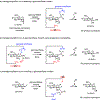Chemoenzymatic Methods for the Synthesis of Glycoproteins
- PMID: 30141327
- PMCID: PMC6238085
- DOI: 10.1021/acs.chemrev.8b00238
Chemoenzymatic Methods for the Synthesis of Glycoproteins
Abstract
Glycosylation is one of the most prevalent posttranslational modifications that profoundly affects the structure and functions of proteins in a wide variety of biological recognition events. However, the structural complexity and heterogeneity of glycoproteins, usually resulting from the variations of glycan components and/or the sites of glycosylation, often complicates detailed structure-function relationship studies and hampers the therapeutic applications of glycoproteins. To address these challenges, various chemical and biological strategies have been developed for producing glycan-defined homogeneous glycoproteins. This review highlights recent advances in the development of chemoenzymatic methods for synthesizing homogeneous glycoproteins, including the generation of various glycosynthases for synthetic purposes, endoglycosidase-catalyzed glycoprotein synthesis and glycan remodeling, and direct enzymatic glycosylation of polypeptides and proteins. The scope, limitation, and future directions of each method are discussed.
Conflict of interest statement
Notes
The authors declare no competing financial interest.
Figures














































Similar articles
-
Chemoenzymatic Glycan Remodeling of Natural and Recombinant Glycoproteins.Methods Enzymol. 2017;597:265-281. doi: 10.1016/bs.mie.2017.06.006. Epub 2017 Jul 5. Methods Enzymol. 2017. PMID: 28935106 Free PMC article.
-
Glycosynthases enable a highly efficient chemoenzymatic synthesis of N-glycoproteins carrying intact natural N-glycans.J Am Chem Soc. 2009 Feb 18;131(6):2214-23. doi: 10.1021/ja8074677. J Am Chem Soc. 2009. PMID: 19199609 Free PMC article.
-
Chemical and chemoenzymatic synthesis of glycoproteins for deciphering functions.Chem Biol. 2014 Jan 16;21(1):51-66. doi: 10.1016/j.chembiol.2014.01.001. Chem Biol. 2014. PMID: 24439206 Free PMC article. Review.
-
Chemoenzymatic synthesis of glycopeptides and glycoproteins through endoglycosidase-catalyzed transglycosylation.Carbohydr Res. 2008 Jul 21;343(10-11):1509-22. doi: 10.1016/j.carres.2008.03.025. Epub 2008 Mar 27. Carbohydr Res. 2008. PMID: 18405887 Free PMC article. Review.
-
Generation of a Mutant Mucor hiemalis Endoglycosidase That Acts on Core-fucosylated N-Glycans.J Biol Chem. 2016 Oct 28;291(44):23305-23317. doi: 10.1074/jbc.M116.737395. Epub 2016 Sep 14. J Biol Chem. 2016. PMID: 27629418 Free PMC article.
Cited by
-
Machine assembly of carbohydrates with more than 1,000 sugar units.Nature. 2022 Oct;610(7931):266-267. doi: 10.1038/d41586-022-02927-x. Nature. 2022. PMID: 36175562 No abstract available.
-
Strategies for chemoenzymatic synthesis of carbohydrates.Carbohydr Res. 2019 Jan 15;472:86-97. doi: 10.1016/j.carres.2018.11.014. Epub 2018 Nov 24. Carbohydr Res. 2019. PMID: 30529493 Free PMC article. Review.
-
Cell-free N-glycosylation of peptides using synthetic lipid-linked hybrid and complex N-glycans.Front Mol Biosci. 2023 Sep 12;10:1266431. doi: 10.3389/fmolb.2023.1266431. eCollection 2023. Front Mol Biosci. 2023. PMID: 37767159 Free PMC article.
-
Considerations for Glycoprotein Production.Methods Mol Biol. 2024;2762:329-351. doi: 10.1007/978-1-0716-3666-4_20. Methods Mol Biol. 2024. PMID: 38315375
-
Bromine-Promoted Glycosidation of Conformationally Superarmed Thioglycosides.Chemistry. 2019 Sep 12;25(51):11831-11836. doi: 10.1002/chem.201901969. Epub 2019 Aug 20. Chemistry. 2019. PMID: 31286579 Free PMC article.
References
Publication types
MeSH terms
Substances
Grants and funding
LinkOut - more resources
Full Text Sources
Other Literature Sources

